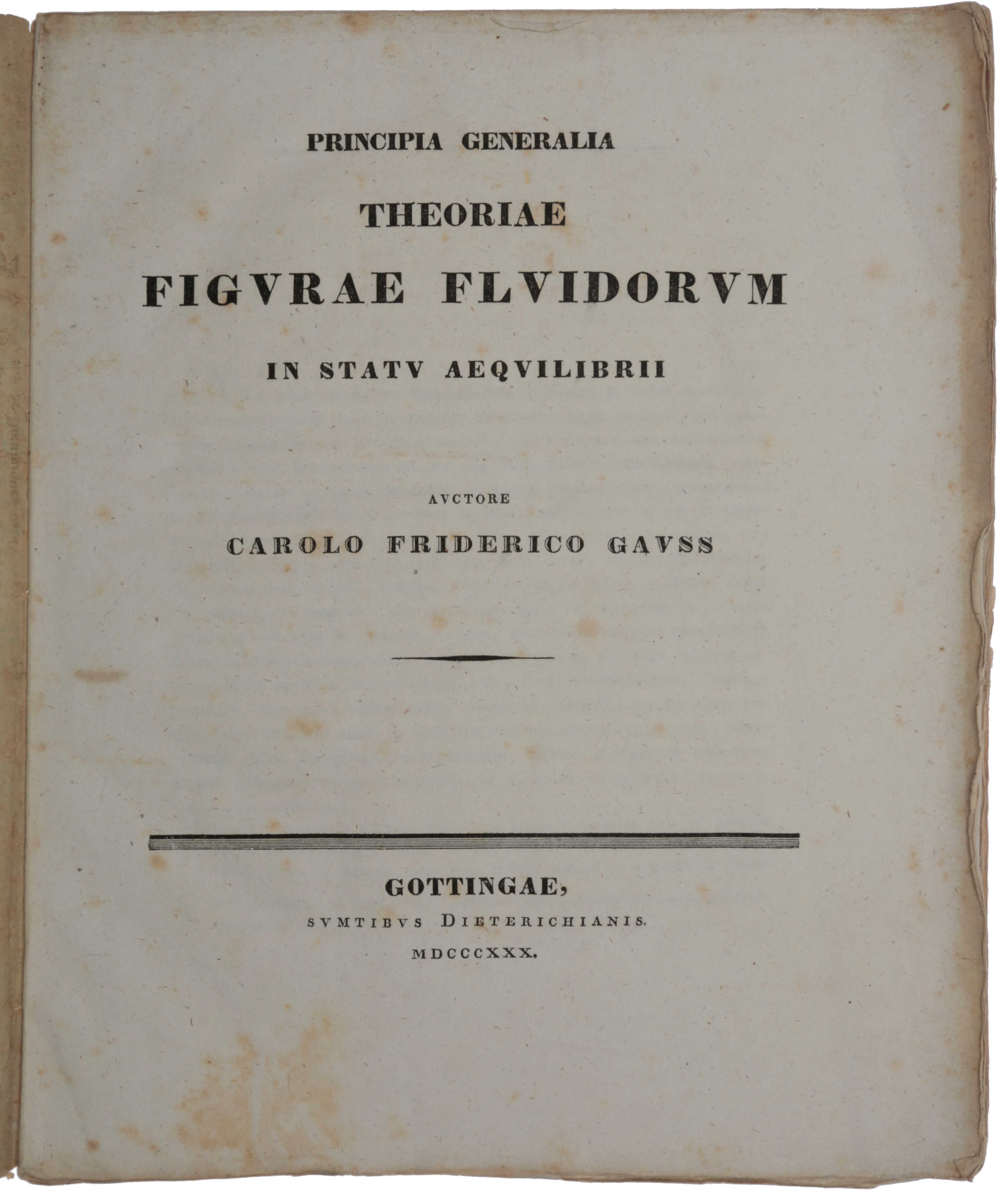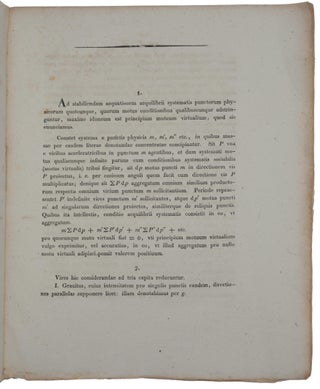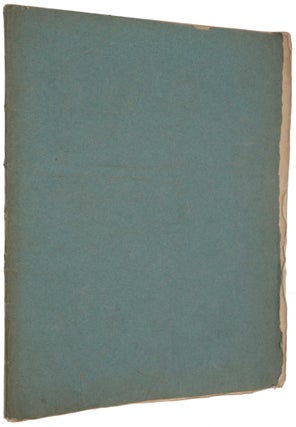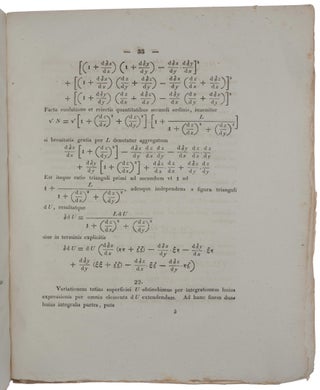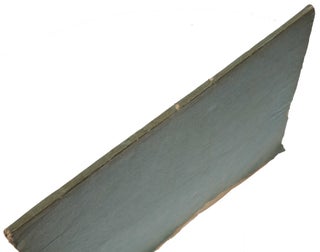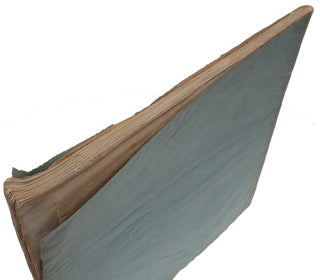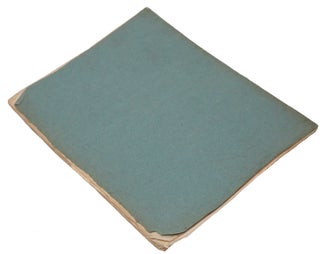Principia generalia theoriae figurae fluidorum in statu aequilibrii.
Göttingen: Dieterich, 1830. First edition, the rare separately-paginated offprint, and a fine copy in original state, of this early contribution of Gauss (1777-1855) to mathematical physics, which contains a fundamental and groundbreaking contribution to the calculus of variations. “Gauss ranks, together with Archimedes and Newton, as one of the greatest geniuses in the history of mathematics” (Printing & the Mind of Man, p. 155). He is best known today for giving the first satisfactory proof of the fundamental theorem of algebra (1799), for Disquisitiones arithmeticae (1801), which revolutionized number theory, and for Disquisitiones generales circa superficies curvas (1828), which laid the foundations of differential geometry. The present work deals with the theory of capillary action, the rise or fall of liquids in narrow tubes, the foundations of which were laid by Thomas Young in 1805, who provided a qualitative theory for surface tension, and by Pierre-Simon Laplace, who mathematically formalized the relationship described by Young a year later. Gauss wrote that Laplace’s “investigations, which have found their confirmation in striking agreement with careful experiments, are among the most beautiful enrichments of natural science that we owe to the great mathematician” (translation from p. 2). However, Laplace’s theory depended on hypotheses about molecular forces, which were little known at the time, and so open to criticism, by Young among others. “The principle which [Gauss] adopted is that of virtual velocities, a principle which under his hands was gradually transforming itself into what is now known as the principle of the conservation of energy. Instead of calculating the direction and magnitude of the resultant force on each particle arising from the action of neighbouring particles, he formed a single expression which is the aggregate of all the potentials arising from the mutual action between pairs of particles … With its sign reversed it is now called the potential energy of the system … The condition of equilibrium is that this expression shall be a minimum. This condition when worked out gives not only the equation of the free surface in the form already established by Laplace, but the conditions of the angle of contact of this surface with the surface of a solid. Gauss thus supplied the principal defect in the great work of Laplace” (Britannica). To find the conditions under which the potential energy is a minimum, Gauss used the calculus of variations and his own generalization of d’Alembert’s ‘principle of virtual work’.In the process he created the method for varying double integrals with variable limits, a problem that both Euler and Jacobi had failed to solve. “In 1830 appeared Principia generalia theoriae figurae fluidorum in statu aequilibrii, his one contribution to capillarity and an important paper in the calculus of variations, since it was the first solution of a variational problem involving double integrals, boundary conditions, and variable limits” (DSB). “Gauss had always been interested in physics …[This] is a theoretical paper, not connected to any experiment … one of Gauss’s objectives appeared to be to show how much mathematics could contribute to the elucidation and explanation of nature … Principia generalia should be counted among Gauss’s work in the calculus of variations. It also contains interesting results in potential theory … it is closely connected to Gauss’s other work in this area” (Bühler, pp. 121-3). This is an offprint from Commentationes Societatis Regiae Scientiarum Göttingensis. It was published in Vol. VII (1832), pp. 39-88 of the Commentationes Classis Mathematicae. As was often the case with the Commentationes, articles appeared in offprint form before the publication of the journal, in this case two years before. Gauss offprints are rarely found in original state as here. ABPC/RBH list only two other copies, both in modern bindings (one with library stamps). “Capillary phenomena and their explanation have undergone a considerable change of status in the physical sciences. Whereas the rise or fall of liquids in tubes or the apparent attraction or repulsion of small floating bodies figure only in subordinate chapters in 20th-century textbooks or in specialized monographs, these phenomena claimed a prominent place in general physics from the early 18th well into the late 19th century. An account of capillarity phenomena formed part of Newton’s programme, contained in the last Query in the second English edition of his Opticks (1718), to explain chemical, optical and other phenomena related to cohesion in terms of strong, short-range forces between the microscopic constituents of bodies. For James Clark Maxwell in 1870, the study of capillary action helped to smooth ‘the path which leads to the development of molecular physics.’ The theory of capillarty was indeed, after the kinetic theory of gases, the most intensively cultivated field of 19th-century molecular physics” (Rüger, p. 1202). At the end of the 18th century, “Laplace developed his programme of reducing ‘the phenomena of nature … ultimately to action ad distans between molecules’. Optical refraction and capillary action figured as the first applications of ‘Laplacian physics’; elasticity, heat, electricity, magnetism and chemical affinities were to follow. “In the first supplement to book 10 of his Mécanique céleste (1806), Laplace calculated the pressure that a curved surface exerts on the column of liquid in a capillary tube. This capillary pressure is proportional to the mean curvature of the meniscus. According to whether the curvature is negative (concave) or positive (convex), the pressure will be smaller or greater than the pressure under a plane liquid surface, and this pressure difference will cause the liquid in the tube to rise above or sink below the level of the plane surface. Laplace’s main result was the differential equation for the free surface of the liquid. Integrating this equation … requires a fixed angle of contact between liquid and solid as a boundary condition … “The molecular theory of capillarity, however, was incomplete in several respects. First, Laplace had not considered repulsive forces between molecules … Thus, he had chosen a quite special molecular model that was in conflict with generally accepted belief. Second, the boundary condition, the constancy of the angle of contact between liquid and solid body, was not deducible from the theory but had to be postulated independently. “Both defects loomed large in Thomas Young’s polemic against Laplace’s theory. About a year before Laplace, Young had devised his own theory in terms of surface tension. He derived the equation for the capillary surface from considering the surface as analogous to an elastic membrane. These results were independent, Young claimed, of the special molecular models of the French … “Laplace’s theory survived criticisms of this sort unimpaired, and remained in excellent agreement with observations. It was only in 1831 that Siméon-Denis Poisson, in his attempt to radicalize the Laplacian programme into a truly molecular mechanics, cast a dark shadow on the theory of his teacher … Poisson’s complex arguments led to expressions for the capillary pressure in terms of intermolecular forces that differed from Laplace’s … Poisson had suggested a different mechanism for capillary phenomena, which led to the same observable consequences as the Laplacian mechanism. “This ‘mathematical scandal’ (as Dominique François Arago called it) in the French school of theoretical physics supplied its opponents – in particular some German and many British physicists – with welcome arguments against the molecular approach in general. The moral these physicists drew from this case was that derivations from specific microscopic models (as opposed to phenomenological processes) were generally of very dubious merit since their premises were, to a great extent, arbitrary. “Carl Friedrich Gauss had in fact already succeeded, in 1830 [in the present work], in formulating a theory of capillarity that … was much less vulnerable to criticism directed against speculative models of the microscopic constitution of matter. The essential ingredients of Gauss’s theory were the potential energies associated with the acting forces (gravity, cohesion, and adhesion). Applying the calculus of variations to this problem, Gauss required the sum of all the potential energies to become extremal, which led to the equation of the capillary surface and to the rule about the constant angle of contact. One of the advantages of this ‘energeticist’ approach was that no detailed consideration of how the capillary pressure arises from the combined force effects of the molecules were necessary” (ibid., pp. 1203-5). The techniques used by Gauss in Principia generalia depend on a purely theoretical contribution to mechanics he published a few months earlier, namely ‘Über ein neues allgemeines Grundgesetz der Mechanik’ (Journal für die reine und angewandte Mathematik 4 (1829), pp. 232-5). “Using ideas which go back to Maupertuis and d’Alembert, Gauss derives a new, comprehensive, extremal principle of mechanics, the principle of least constraint. The basic assumption of the paper is that any movement of a mechanical system at an arbitrary moment is in maximal agreement with the free movement, in other words, that minimal constraints always prevail. This approach allowed Gauss unified treatment of static and dynamic mechanical problems. The measure of the constraints of a system at a given time is the sum of the products of the squares of the [virtual] displacement of each point and its mass. All the concepts which Gauss used were carefully defined; he also established the connection between his principle and d’Alembert’s principle of virtual displacements which is closely related but weaker” (Bühler, pp. 121-2). “It was Gauss’s aim [in the Principia generalia] to derive Laplace’s results in a rigorous manner and by a completely different route. His method is essentially an application of his principle of least constraint to virtual displacements as they had been generalised by Fourier (from equations to inequalities). Mathematically, the paper is an application of the calculus of variations; physically, it proves that Gauss’ principle is in fact stronger than d’Alembert’s, a consequence of which Gauss himself was apparently not aware. “We quote Gauss for one of his most interesting results directly, from the instructive summary which he prepared for the Göttingsche Gelehrte Anzeigen: ‘Let s be the volume of the fluid, h the distance of its barycentrer [centre of gravity] from an arbitrary horizontal plane, T the volume of that part of the surface of the fluid which touches the container, and U the volume of the other (free) part of this surface; then, in equilibrium, the expression sh + (αα - 2ββ)T + ααU is at a minimum, where α and β are certain constants which depend on the relation between the weight and the intensity of the molecular attraction of the particles of the fluid towards each other and of the walls of the container towards the fluid. ‘We see that we obtain, as a result of a difficult and subtle investigation, a condition for the equilibrium which is accessible even to the common mind and which shows the adjustments which take place in the conflict between the various prevalent forces. If gravity was the only force, the barycenter of the fluid would have to be as deep as possible, i.e., h would have to be at a minimum. If one were to set aside gravity and the attraction of the container and only consider the mutual attraction of the particles of the fluid, the surface would assume a spherical shape, i.e., T + U would be at a minimum. If there were finally no gravity nor any mutual attraction among the particles of the fluid, it would spread over the surface of the container so the T would be at a maximum, or –T at a minimum. It is not surprising that a joint action of the three forces will minimize an aggregate of the three factors though one has to understand that the proper derivation of this theorem has to be based on complete and rigorous mathematical conclusions which largely depend on the nature of the molecular attraction.’ “As an easy corollary one obtains formulas of the rise and fall of fluids in capillary containers. Gauss also investigated the effects of friction, less simply shaped containers, etc.” (ibid., pp. 122-3). Gauss’s ‘rigorous mathematical conclusions’ were reached using the calculus of variations, an extension of the application of calculus to finding maximum and minimum values of a given quantity to situations in which the quantity being varied is, rather than simply a number, a function, in this case one that describes the shape of the surface of the fluid. “This topic was first studied in the 18th century, when it was developed for the treatment of extremal problems in mathematical physics; for physical as well as for mathematical and philosophical reasons, the calculus of variations with a central theme of 18th-century mathematics. “The tools for the solution of extremal problems are integration by parts and integral transformations. Two kinds of difficulties occur. First, the mathematical formulation of an extremal problem is often not clear, and it may not be obvious which of the several possible approaches will lead to a solution. It is particularly difficult to find the correct or most suitable boundary conditions. The second basic problem consists in developing, within the framework of the differential and integral calculus, an adequate and mathematically correct method for the formulation and execution of the variations … “None of Gauss’s papers is devoted directly and specifically to the calculus of variations; his most important efforts are rather contained in Principia generalia theoriae figurae fluidorum in statu aequilibrii, which one would consider a contribution to mathematical physics, and in Disquisitiones generals circa superficies curvas (1828), his basic paper in differential geometry. One sees in both these papers how familiar Gauss was with the theory and practice of integration and how well-equipped he was to tackle a variational problem directly” (ibid., pp. 106-7). In Principia generalia, the problem is reduced to the variation of an expression, given by a double integral extended over the surface of the fluid, for what is essentially the energy of the fluid surface. The variation is subject to a constraint, namely that the total volume of the fluid is constant (this is also expressed as a double integral). “Gauss solved his problem in three steps: (i) Formulation of the first variation. (ii) Transformation of the first variation by integration by parts. (iii) Derivation of a partial differential equation and of its boundary conditions. “[In the second step], with the help of purely geometric arguments, one can transform [the double integral expressing the variation of the surface] into a line integral along the boundary of the [surface] – this is, in fact, a generalization of Green’s theorem and is known as Gauss’s divergence theorem” (ibid., pp. 108-9). Green’s theorem appeared in George Green’s Essay on the Application of Mathematical Analysis to the Theories of Electricity and Magnetism (1828), a work that was unknown outside England. Gauss’s divergence theorem has been a fundamental tool in mathematical physics since it was first used by Gauss. Poggendorff I, 855. Bühler, Gauss. A Biographical Study, 1981. Rüger, ‘Capillarity,’ Chapter 9.9 in Companion Encyclopedia of the History and Philosophy of the Mathematical Sciences (Grattan-Guinness, ed.), Vol. 2, 2003.
4to (260 x 215 mm), pp. [ii], [1], 2-53, [1, blank], uncut. Original plain wrappers. A very fine copy in original state.
Item #5927
Price: $1,850.00

